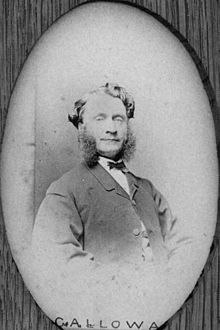Hawkesbury People & Places
John James Galloway

Though not as well remembered nor applauded as Mitchell, Oxley or Evans, surveyor and explorer John James Galloway made a significant contribution to the accurate measuring, describing and mapping of land in the colony of New South Wales and Queensland in the 19th century.
Galloway was born and educated in Leith, Scotland in 1818, the only son of Dr Thomas Galloway and his wife Elizabeth. Thomas Galloway was appointed to the position of surgeon to the Royal Navy in September 1801. As a man of means, Dr Galloway could provide well for his family and ensure that his son was well educated and receiving proficient training and experience in a chosen profession - surveying. During the 19th century many surveyors received their qualifications by being articled to a private surveyor who charged for training, board and lodging.
From 1830 until 1841, Dr Galloway made numerous voyages to NSW as surgeon on both convict and immigrant ships. Over this time he became well acquainted with the many opportunities available in the colony for well-educated and ambitious immigrants.
Accompanying his father aboard the convict transport Susan, John James Galloway aged 19 years arrived in the colony in February 1836. He gained a position with the office of the Surveyor General of NSW, the largest government department in the colony at that time. Shortly after his arrival in NSW, Galloway commenced work as a draftsman before progressing to an assistant surveyor in February 1838.
The role of the department was to measure and determine the boundaries of all land granted in the colony before it could be occupied. The increasing volume of grants being given placed additional demands upon the team of clerks, draftsmen and surveyors.
In June 1837 Galloway surveyed part of the County of Murray bounded by the Murrumbidgee, Shoalhaven and the Yass Rivers. His work then took him to many locations in and around Sydney including Prospect, Castlereagh, Alexandria and Campbelltown where he drafted plans of church lands in those areas.
The towns of Windsor and Richmond were covered in great detail during 1841. The plans include the boundaries of portions of land in each town together with the names of owners and occupiers. The outlines of buildings as well as some descriptions such as the names of hotels give a fascinating snapshot of each town at this time. Several buildings marked on Galloway’s detailed survey of Richmond still exist today including Bowman Cottage and St Peter’s Church in Windsor Street, Rutherglen in March Street, Clear Oaks in Francis Street and Mortimer’s Cottage in Bosworth Street.
In February 1842 Galloway was appointed Commissioner of Crown Lands for the County of Cumberland. His duties included the management of government lands such as the issue of licences for the grazing of stock. During 1843 he undertook surveys of church lands in the towns of Windsor and Richmond and in September produced a plan of the town of Pitt Town. In Parramatta, he produced detailed plans of the town including boundaries and names of owners and occupiers.
The town of Port Macquarie was surveyed in July 1845 after which he traversed the country from Emu Plains, to Burragorang before moving on to the New England region in 1848. Working alone and often away from civilization for months at a time, the harsh Australian climate took its toll on the health of many surveyors. The work was arduous, exacting and physically demanding as instruments and supplies were often carried on foot due to the rugged nature of the uncharted terrain.
Galloway’s deteriorating health necessitated that he take leave of absence in the early 1850s, returning to the colony in January 1854. He was little recovered from his sojourn in England and he was required to take up his duties on his return by Surveyor General Mitchell. There was often conflict between Galloway and Mitchell who took every opportunity to criticise and belittle Galloway’s meticulous work.
Further surveys of the New England region were completed during 1854 before travelling to Moreton Bay the following year to commence survey and exploration of the area including Dalby, Toowoomba and Brisbane. In February 1860 aged 42 years, Galloway retired from service and was awarded a pension of £143 19 shillings 9 pence per annum. In 1859 the new state of Queensland had been created and Galloway took the opportunity to take part in its first legislature. He served two terms in the Queensland Legislative Council from May 1860 until May 1865 and again from November 1869 until April 1872.
In 1875 he again took an extended holiday to Europe and Britain and in June 1883 at the age of 64 years he died suddenly in Brussels, Belgium and was buried in Devon, England.
(An abridged version of this article by Cathy McHardy was published in the Hawkesbury Gazette in December 2019 on behalf of the Hawkesbury Family History Group)
Source: State Library of Queensland
Reference: Member of the First Queensland Parliament 1860
Image credit
Property Research Service
Have you ever wondered when your house was built or who has owned your property over the years?
